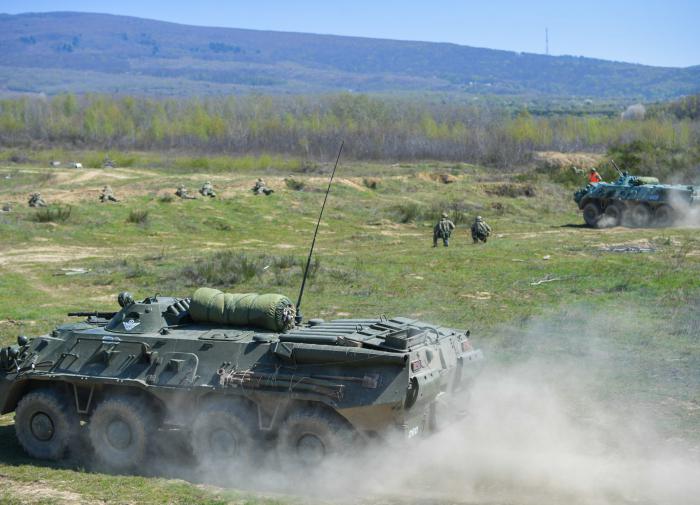On Sunday, September 27, Azerbaijan launched a large-scale military operation on the line of contact in Karabakh. Azerbaijan reported the capture of several settlements in the region, while Azeri President Ilham Aliyev announced that the Armenian side suffered serious damage.

Armenian Prime Minister Nikol Pashinyan announced that Azerbaijan attacked the unrecognized republic of Nagorno-Karabakh. Armenia and Nagorno-Karabakh declared martial law and mobilization.
The Russian Foreign Ministry called for an immediate ceasefire in the conflict zone, while Turkey announced its support and readiness to help Azerbaijan.
The hostilities began at 6 a.m. after the Azerbaijani Defense Ministry announced an intense shelling of Azerbaijani positions on the contact line in Karabakh and adjacent villages.
The armed forces of Azerbaijan launched an active "counter-offensive operation" along the entire line of contact with Armenia, said Anar Eyvazov, press secretary of the Azerbaijani Defense Ministry. The purpose of the operation of the Azerbaijani military is to "prevent provocations" from the Armenian side, Azerbaijani officials said.
According to Eyvazov, the Azerbaijani military destroyed a significant amount of equipment, military facilities and manpower of the enemy both on the front line and in the depths of defense. As many as 12 "Osa" ("Wasp") anti-aircraft missile systems were destroyed, the official said.
"The Armed Forces of Azerbaijan had one combat helicopter damaged, but the pilot was able to land, no one was killed," the ministry spokesman added.
"The personnel and tank units, with the support of units of the rocket and artillery troops, front-line aviation and unmanned aerial vehicles, having detected manpower, military facilities and hardware of the Armenian Armed Forces on the front line and in the depths of the enemy's defense, destroy them," the Azerbaijani Defense Ministry said in a statement.
The Defense Ministry of Azerbaijan denied information about the destruction of Azerbaijani tanks, helicopters and UAVs by the Armenian military.
"The information disseminated by the Armenian side about three destroyed tanks, two helicopters and three unmanned aerial vehicles (UAVs) of the Azerbaijani army is a lie and disinformation," the ministry said.
Twelve units of "OSA" anti-aircraft missile systems of Armenian air defense units were destroyed in different directions, the Azerbaijani Defense Ministry reports. It also said that a combat helicopter of the Air Force of Azerbaijan was shot down, the crew survived.
Azerbaijani President Ilham Aliyev said at a meeting of the Security Council that Azerbaijani troops inflicted serious damage on the enemy during the operation in the Karabakh conflict zone. Aliyev blamed the Armenian side for the aggravation in Karabakh and congratulated the Azerbaijani people "on the successful counteroffensive" and expressed confidence that it would lead to the restoration of the territorial integrity of the country.
Vahram Poghosyan , the press secretary of the President of Nagorno-Karabakh wrote on his Facebook page that "the units of the defensive army of Nagorno Karabakh strike powerful blows to prevent the actions of the enemy."
Azerbaijan uses Grad volley-fire systems to shell the city of Stepanakert and other settlements of Karabakh.
The press secretary of the Armenian Defense Ministry, Shushan Stepanyan, said that the attacks of the Azerbaijani Armed Forces in several directions of the line of contact with Nagorno-Karabakh were repulsed. "The enemy suffered losses in manpower and military hardware. Three Azerbaijani tanks were destroyed. The fighting continues," Stepanyan wrote on her Facebook page.
On Sunday morning, Armenian Prime Minister Nikol Pashinyan announced that Azerbaijan attacked the unrecognized Republic of Nagorno-Karabakh.
"The enemy launched an attack on Artsakh (the Armenian name for Karabakh). The Army of Defense is resisting the attack successfully. The situation is in a state of operational development," Pashinyan wrote on his Facebook page.
Casualties were reported among the civilian population of Karabakh. Artak Beglaryan, ombudsman of the unrecognized Nagorno-Karabakh Republic, told reporters that a child and a woman were killed in Martuni region, schools in Stepanakert were shelled.
"There is large-scale destruction of civilian objects in numerous settlements," Beglaryan said, noting that the Azerbaijani Armed Forces inflicted numerous strikes on civilian targets in Nagorno-Karabakh.
On Sunday, the press service of the Defense Ministry of the unrecognized republic reported fierce battles in the zone of the Armenian-Azerbaijani conflict. "The settlements located deep in the rear, as well as the capital of Stepanakert, were targeted," the press service of the Defense Ministry said.
History of Nagorno Karabakh conflict
During the early 1990s Azerbaijan lost control over the territory of Nagorno-Karabakh and seven regions as a result of a conflict with the Armenian population of the region and Armenia.
Ceasefire between Armenia and the self-proclaimed Nagorno-Karabakh Republic on one side and Azerbaijan on the other side was established in May 1994.
Presently, negotiations are mediated by the OSCE Minsk Group, which was set up in 1992 to find ways to peacefully resolve the Nagorno-Karabakh conflict. The group includes Azerbaijan, Armenia, Belarus, Germany, Italy, Sweden, Finland and Turkey. The group is co-chaired by Russia, France and the United States.
Azerbaijan does not consider the self-proclaimed republic of Nagorno-Karabakh a party to the conflict and refuses to conduct negotiations with it.
Another outbreak of tensions on the Armenian-Azerbaijani border took place in mid-July. Clashes on the border began on July 12 and continued through July 15 in the adjacent regions - Tovuz (Azerbaijan) and Tavush (Armenia), which also border on Georgia and are located hundreds of kilometers from Nagorno-Karabakh, where the situation remained calm. By the end of July, the situation had stabilized, but remained tense.
After the crisis on the Armenian-Azerbaijani border in July, the head of the Armenian government declared the need to strengthen the system of common security of Armenia and Karabakh. He also called for the organization of process to constantly monitor ceasefire between Armenia and Azerbaijan.
No comments :
Post a Comment